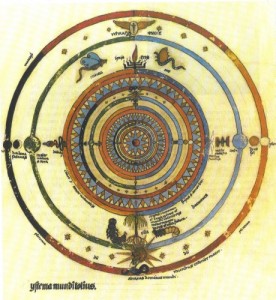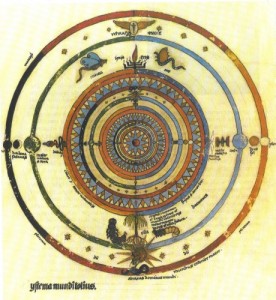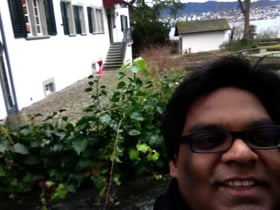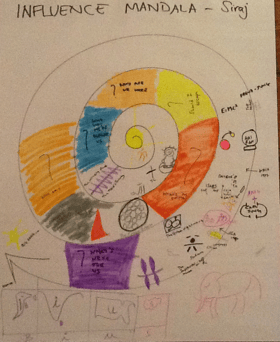(This is the first in a series of posts about Carl Jung and his amazing wealth of knowledge)
Introduction:
Carl Jung introduced the concept of the Collective Unconscious as follows:
“The Collective Unconscious is a part of the psyche which can be negatively distinguished from a personal unconscious by the fact that it does not, like the latter, owe its existence to personal experience and consequently is not a personal acquisition...Whereas, the personal unconscious consists for the most part of complexes, the content of the collective unconscious is made up essentially of archetypes.”
Through this post, I will explore the following:
- Jung’s thoughts on the “collective unconscious” and its significance.
- The relevance and applicability of this concept to my own life.
- A critique of Jung's thoughts and possible limitations to his approach.
The Collective Unconscious:
In 1909, on a voyage to America with Freud, Jung had a very interesting dream that led him to the concept of the Collective Unconscious. Jung describes his very interesting dream as below:
I was in a house that I did not know,which had two stories. It was "My House". I found myself in the upper story, where there was a kind of salon furnished with fine old pieces in rococo style. On the walls hung a number of precious old paintings. I wondered that this should be my house, and thought , "Not bad". But then it occurred to me that I did not know what the lower floor looked like. Descending the stairs, I reached the ground floor. There everything was much older, and I realized that this part of the house must must date from about the fifteenth or sixteenth century. The furnishing were medieval; the floors were of red brick. Everywhere it was rather dark. I went from one room to another, thinking, "now I really must explore the whole house". I came upon a heavy door, and opened it. Beyond it, I discovered layers of brick among the ordinary stone blocks, and chips of brick in the mortar. As soon as I saw this I knew that the walls dated from Roman times. My interest was by now intense. I looked more closely at the floor. It was of stone slabs, and in one of these I discovered a ring. When I pulled it, the stone slab lifted, and I again I saw a stairway of narrow stone steps leading down into the depths. These, too, I descended, and entered a low cave cut into the rock. Thick dust lay on the floor, and in the dust were scattered bones and broken pottery, like remains of a primitive culture. I discovered two broken skulls, obviously very old and half disintegrated. Then I awoke.
Over the next few years, Jung continues to dive deeper into the Collective Unconscious and moves away from Freud’s structure of the psyche (Id-Ego-SuperEgo) to his own structure (Ego-Personal Unconscious-Collective Unconscious).
At this stage I would like to point out that Jung goes deeper into his model of the psyche. Here is the detailed outline:
- Ego - Conscious Ectopsychic Sphere - This has four ectopsychic functions (Sensation-Thinking-Feeling-Intuition)
- Ego - Conscious Endopsychic Sphere - This has four ectopsychic functions (Memory-Subjective Components of Conscious Functions - Emotions & Affects- Invasion)
- Personal Unconscious - consists of complexes.
- Collective Unconscious - consists primary of archetypes and instincts.
For me, this provides a tremendous insight into the nature of our psyche and leads me to appreciate the true power of the discovery of the concept of Collective Unconscious. What is also powerful is that the at the deepest level of our being, we are all connected deeply. (BTW, this leads me to my second favorite author / mentor - Martin Buber - who’s book and concept of “I and Thou” is probably the second foundation of my personal belief).
Another interesting aspect relates to Jung’s statement that “We cannot directly explore the unconscious psyche because the unconscious is just unconscious, and we have therefore no relation to it...Whatever we have to say about the unconscious is what the conscious mind says about it.”
So, now the question is, how do we prove the existence of the Collective Unconscious and its contents (archetypes).
Carl Jung stated that dreams were the main source of proof. He further clarified that “From those which are known to him we must naturally exclude all motifs which might be known to him...We must look for motifs which could not have possibly be known to the dreamer and yet behave functionally in his dream in such a manner as to coincide with the functioning of the archetype known from historical sources.”
He also mentions “active imagination” as another source for the unconscious material (but that is a completely new blog post for the future).
One more very interesting contribution by Jung is the application of Mandala symbolism. The word Mandala comes from Sanskrit and means “circle”. The drawing of Mandalas is very common in Indian and Buddhist tradition. Jung painted several exquisite and detailed Mandalas and a few of these are part of his Red Book. Jung said “As a rule, we see this causal relationship in reverse: in the products of the unconscious we discover mandala symbols, that is, circular and quaternary figures which express wholeness, and whenever we wish to express wholeness, we employ just such figures.”
The South Indian tradition of Mandala is commonly called as “Kollam” and I have witnessed several thousand such “Kollams” growing up in India. In fact, Jung mentions the great temple of Madura where he saw a woman drawing a colorful Mandala / Kollam and I have visited this temple (Meenakshi Amman Temple) several times and seen these beautiful Kollams. The women who draw these complex Mandalas have no set design / pattern that they follow. Every day a new Kollam is drawn from their dreams and the Collective Unconscious.
My favorite Mandala is Jung’s first Mandala Systema Munditotius (The system of all worlds).
Systema Munditotius (1916) - Jung’s first Mandala (The Red Book)
Personal Applicability:
“So, waiting, I have won from you the end: God’s presence in each element” - Goethe
The first Jungian inspiration I can remember was in 1989 at my friends home in Trichy, India. They (Francis and Josephine Fernandez) were dear friends and allowed me to read several books from their library. In addition to their love that gave room for my personal growth, I experienced intellectual growth from our conversations, labs, workshops and books. One of the books that I was attracted to was “Analytical Psychology - Its Theory & Practice” by Carl Jung. This amazing book is a record of Carl Jung’s lectures to the Tavistock Institute in 1935. I remember very well the concept that shook my world was that of the Collective Unconscious. The discovery that we are all united in our memories, dreams, reflections, histories and myths at such a deep level was astonishing.
While I was inspired by the Collective Unconscious, I was curious to know if my life would allow me the ability to access this vast source. But the question for me was why was this “Collective” hidden from me? Why was it “Unconscious”? How can I find & access our (hidden) collectiveness again and again? The search for this mystery has defined my life and my purpose.
Here is a poem I wrote in 1991, inspired by the concept of Collective Unconscious. This poem is appears on the flip side of my business card and is probably the best introduction to my life that I can give any stranger. This has had the best reaction of connecting me immediately to those who recognize their own Collective Unconscious and the strangest looks from those who have never heard of the Collective Unconscious.
Mystery Soulmate
I was only a drop
In the great dream-ocean
Of the Lord;
Yet I was
A universe unto myself
Within my water-shell;
Will I remain:
Undiscovered,
Unvisited, &
Unknown
Even to myself?
Several subsequent experiences brought me close to the Collective Unconscious and I had several “Moments of Transformation” in my personal and professional life. A few personal stories:
Meeting and committing to Raji (my future wife) in 1992, who was not from my cultural and religious background but who clearly was a part of my future. This event could only have emerged from the Collective Unconscious.
Similarly, meeting and committing to her baby girl - Pallavi (my future daughter) who again, clearly was a part of my future story. I still remember the first time I saw Pallavi (Sep 1992) - a shy baby girl blushing in the corner of the room and I could sense the Collective Unconscious in her being.
These were two separate human beings who suddenly allowed me to see my deep connection, to other human beings of different cultures, vividly and thus sealed my deep appreciation of the Collective Unconscious.
The conception of our second daughter (Amaani) in 1996 connected me to the soul of humanity that was waiting in the Collective Unconscious for the right time to emerge. My future was now inside our pregnant womb.
My daughter Amaani’s birth in 1997 allowed me to connect to the whole collective at will. She gave birth to something in me that enabled the collective to come alive and remain with me at all times. Becoming a father has been a great way to experience the Collective Unconscious. My daughters (Pallavi and Amaani) were revealed to me in my dreams. They allow me to observe how the great collective unconscious unfolds and emerges right in front of me as they grow into beautiful women.
Now, I work professionally as an Organizational Transformation Consultant and naturally, I apply the concept of Collective Unconscious in my work. I apply the device of Mandalas in helping my client executives understand their dreams and personal visions. The challenge I pose to them is to discover if as a group of executives leading the company, they are all aligned in their dreams and visions and can create a Compelling Shared Vision for their enterprise that is a powerful and uniting force. In other words do they truly understand and appreciate the Collective Unconscious that binds them all.
I am further exploring the concept of Collective Unconscious as it applies to organizations and their future. Assuming, if everything present in an organization came from the Collective Unconscious of its founders / members, then the future of this organization presently resides in their Collective Unconscious. How can we “access this future” and prepare ourselves for “what wants to emerge”? The central question I pose to myself and to my clients is “What does the future of me (us) want from me (us) now?” In many ways, this challenge is one of understanding and respecting the numinous in each of them and in their collective being. To further deepen their spiritual connection and my own sense of awe around this connection, I have chosen to call this approach / method as “Supplication”.
Supplication is a form of prayer in many religious traditions and my understanding is that in order for organizations to access the future, they need to supplicate to the Collective Unconscious. Freud and Jung started this practice by listening to their patients and Jung specifically gave his patients and their Collective Unconscious a lot of respect.
In my own humble way, I am on a similar journey of listening to my client organizations’ and their dreams and Collective Unconscious.
Critique of Jung’s concept of the “Collective Unconscious”:
Ironically, I have to rely on our collective unconscious to even go to the subject of critically looking at Jung’s concept of “Collective Unconscious”!
Why would Jung allow this concept to become so controversial? I wonder if he could have spent his time delving deeper into this concept and creating more clarity around this topic rather than creating other concepts. The thought that also comes to me is that he have given all the knowledge he possessed on the subject and was not given more insight by the Collective Unconscious “itself”.
The second thought I had relates to Jung’s propensity to explore several topics at once. For example, while talking about the Collective Unconscious, he spends more time / text space talking about Archetypes. Again, the way I balance this thought is that there is no way to talk about the Collective Unconscious without talking about Archetypes especially if the Archetypes make up the contents of the Collective Unconscious.
The third thought I had was that the concept of “amplification” was not explained very well and thus not appreciated very well. Jung “amplified” the concept of Collective Unconscious but he was way ahead of his time. I often wonder if we have truly appreciated the depth of this concept even now!
In any case, I am very grateful to Jung for his contributions to my personal growth. The last 25 years of knowing and not knowing the Collective Unconscious has been a very rewarding journey for me.
PS. Thanks to an amazing mentor, James Hollis !



